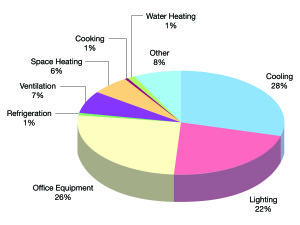As first-level data gathering tools in the facility load-profiling process, submeters provide highly accurate 15- or 30-minute snapshots of energy use (kilowatt-hours or kWh) and demand (kilowatts or kW) — from the enterprise level all the way down to a specific circuit or item of equipment. Submeters are an easily installed, versatile and scalable solution for obtaining the degree of energy intelligence needed to optimize today’s high-rise facility operations by:
- Allocating energy costs to specific lease spaces, tenants, circuits or buildings;
- Profiling entire the facility for demand management, load shedding and energy initiative compliance;
- Aggregating energy demand/use for bulk energy contracts in deregulated markets;
- Implementing demand response/control to avoid costly ratchet charges;
- Integrating HVAC, lighting, other utility meters and other systems into the building management system;
- Diagnosing equipment performance, generating monthly billings and more.
Commercial High-Rises Submeter for Fair and Equitable Allocation
How this plays out in the real world is dramatically illustrated by the former Bank of America Center, a 52-story office high rise in downtown San Francisco that provides 1.5 million square feet of office space and another 45,000 of retail space. Recently certified LEED-EB, the 779’ tall tower was initially submetered back in the 1990s when it became obvious that the building’s 24/7 operation and other factors routinely exceeded the built-in 3kW/sq ft energy allowance given each lease tenant. What began as a gradual metering experiment eventually grew to a facility-wide network of more than 120 electric submeters that for the past several years has allowed the property management company to recover more than $1 million per year in electrical costs.

Commercial building electrical consumption by using source, based on a DOE end-use consumption survey. Notice that lighting, cooling and plug load account for some 75% of all power usage. All building systems represent a great opportunity for submetering.
Similarly, the electrical submetering system at one midtown Phoenix, Arizona high rise is helping building managers to more accurately track and bill energy use. With 34 different tenants, a retail center and a parking garage, the submetering project was motivated by the need to more fairly bill the tenants who, before the installation, paid for energy according to a flat cost-per-square-foot ratio. Tenants that exceeded their preset energy baseline caused the cost differential to be unfairly distributed to other, lower-consuming tenants. Some computer-intensive tenants routinely exceeded their allotted energy use through extended business hours or by having more people or equipment than was recommended for the lease space.
In operation, current sensors on each floor send energy consumption data to the facility’s engineering office, where it is collected and recorded by 80 electric submeters installed in four, eight-meter multiple meter units (MMU) and two, 25-meter MMUs (Figure 2). The meter data is communicated to a PC, where automatic meter reading software analyzes the data and prepares the monthly billing statements for each tenant.
“All the money we recover goes into a ‘kitty,’ operating costs go down and the other tenants benefit,” said the facility’s assistant chief engineer. “People who are using the power are paying for it now. It’s not being spread equally among everybody, which is fairer to the little guy.”
The facility’s $75,000 submeter installation paid for itself in only five months. By billing tenants for their actual energy use, managers were able to reduce operating costs by about 25 cents per square foot. With about 800,000 square feet of submetered office space in the two towers, annual energy savings of about $200,000 are now freeing managers to focus their time on other areas, including capital repairs and improvements.
The Bottom Line is Still the Bottom Line
An inexpensive and easily installed solution to that old energy adage, “You can’t manage what you don’t measure,” submeters are the ideal data acquisition front end for tracking electrical consumption and demand at the enterprise level all the way down to individual circuits of interest (Figure 3). The San Francisco and Phoenix high-rises mentioned above are just two examples of state-of-the-art facilities that are submetering their way to greater energy savings and lower operating costs — the name of the game in today’s increasingly competitive, energy-conscious building environment.
Don Millstein
Don Millstein is President and CEO of E-Mon of Langhorne, PA. As a veteran energy industry speaker and author, Don is a former participant in utility deregulation in California, New Jersey, New York and Penn-sylvania. He is a member of the DOE’s FEMP task force, Alliance to Save Energy, the U.S. Green Building Council and other energy conservation-related organizations. He may be contacted at [email protected].


